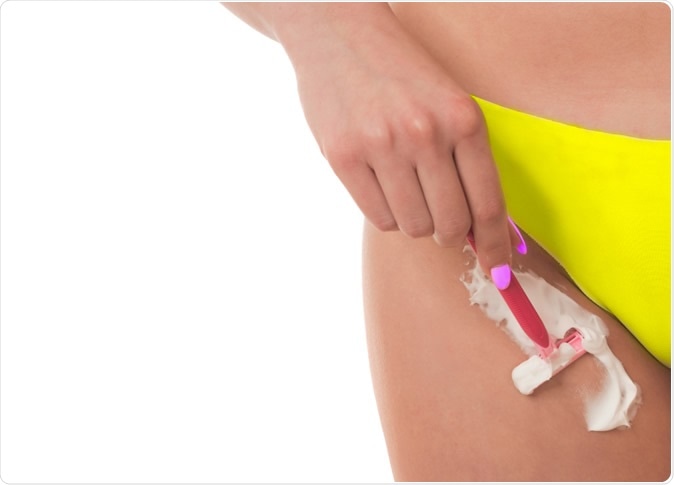Some women shave or wax their pubic hair while others do not. It remains a personal choice but anecdotal reports have suggested a link between extremely groomed pubic region and raised risk of sexually transmitted infections or diseases (STIs or STDs).
A new study proves that there is not reduction in the risk of getting STDs in women who shave or wax off their pubic hair. The team from Ohio State University published their research findings in a study titled, “Association between pubic hair grooming and prevalent sexually transmitted infection among female university students,” in the latest issue of the journal PLOS One.

Image Credit: KlaraBstock / Shutterstock
The researchers included 214 female college students between April 2017 and April 2018in their study. They looked at the risk of getting a confirmed laboratory diagnosis of either chlamydia or gonorrhoea - two common STIs and removal of pubic hair.
For this study the team included all women willing to participate in the study and who visited the on-campus STD testing station at Ohio State. They were all provided with a questionnaire that asked them to report their sexual behaviours as well as pubic grooming habits anonymously. Results from the questionnaires revealed that nearly 98 percent of the participants had tried some form of grooming for their pubic region. They noted that 53.6 and 18 percent of the participants were “extreme” groomers meaning they had removed all of their pubic hair at least once a week in the past one year or at least six times over the past month respectively. The last two were the measures of extreme grooming used in this study. The team found that 82.9 percent of the responders used a non-electric blade razor, while 41.7 percent used hair removal soap, 41.2 percent used shaving cream for extreme grooming. Of the participants around 63.3 percent reported to have had an injury during extreme grooming.
At the end of the study 9.8 percent of the women tested positive for either Chlamydia or gonorrhoea. There was no association between the two events – the “extreme” grooming and the confirmed STIs wrote the researchers.
Jamie Luster, a former graduate student in public health at Ohio State and now researcher at the University of Michigan and also lead author of the study said that this study proves that neither does extreme grooming of the pubic region raise nor reduce the risk of getting STIs among women. She explained that there are no biological reasons that could connect the two.
The researchers including Ohio State associate professor of epidemiology Maria Gallo, who was one of the advisers to Luster, explained that although this was a small study, it could be important when advising women whether or not to go for extreme grooming of the pubic region to reduce their risk of getting STIs.
Gallo explained, “Particularly concerning is that previous work didn’t adjust for sexual frequency. It could be that women who were having more sex with more people – and were therefore more likely to contract infections – were more likely to be grooming.” She meant that there have been earlier studies that looked at the connection between pubic hair removal and risk of STIs but these have failed to account for the degree of sexual activity among the participant. If a woman was more sexually active with more number of partners, she was more likely to get the infections and also more likely to be shaving or waxing off her pubic hair. Mistakenly it was believed this that extreme pubic grooming was associated with raised risk of STIs, explained Gallo. Other factors that this study took into account but was missed by previous studies were age of the participants, race and income. “Previous research asked participants if they’d ever had a sexually transmitted infection, but didn’t measure whether they had one at the time of survey. That makes connecting any current grooming habits to STDs difficult,” she added.
Authors wrote in conclusion, “Pubic hair grooming was common among female university students attending for STI testing. Findings do not support pubic hair grooming as an STI risk factor in this population.” They added, “Our findings do not support for the need for public health or clinical interventions to address pubic hair grooming as a risk factor for prevalent GC (Gonococcal infection) or CT (Chlamydia trachomatis infection).”
According to the Centers for Disease Control and Prevention (CDC) there are 820,000 and 2.86 million new cases of gonorrhea infections and chlamydia infections annually respectively in the United States. Both of these infections in young women can have long term harmful effects on their reproductive systems as well as on their fertility says the CDC. Despite a multitude of advice on the internet regarding the ways to lower the risk of STIs, the CDC recommends mutually monogamous and long term sexual relationships with a partner who has been tested and is free of STDs and also regular and correct use of latex condoms for intercourse.
This study was funded by a REDCap support Award from the National Center for Advancing Translational Sciences.
Journal reference:
Association between pubic hair grooming and prevalent sexually transmitted infection among female university students Jamie Luster, Abigail Norris Turner, John P. Henry Jr., Maria F. Gallo Published: September 4, 2019, https://doi.org/10.1371/journal.pone.0221303